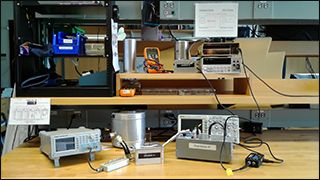Description

Johnson noise and shot noise experiment equipment.
In electronic measurements, one observes “signals,” which must be distinctly above the “noise.” Noise induced from outside sources may be reduced by shielding and proper “grounding.” Less noise means greater sensitivity with signal/noise as the figure of merit. However, there exist fundamental sources of noise which no clever circuit can avoid. The intrinsic noise is a result of the thermal jitter of the charge carriers and the quantization of charge. The purpose of this experiment is to measure these two limiting electrical noises. From the measurements, values of the Boltzmann constant and the charge of the electron will be derived.
Lab Guide
 Johnson Noise and Shot Noise Lab Guide (PDF)
Johnson Noise and Shot Noise Lab Guide (PDF)
References
Johnson, John B. "Thermal Agitation of Electricity in Conductors." The Physical Review 32, no. 1 (1928): 97-109.
Nyquist, Harry. "Thermal Agitation of Electric Charge in Conductors." The Physical Review 32, no. 1 (1928): 110-113.
 Reif, Frederick. "Fourier Analysis of Random Fluctuations." Section 15.13-15 in Fundamentals of Statistical and Thermal Physics. New York, NY: McGraw Hill, 1965, pp. 582-587.
Reif, Frederick. "Fourier Analysis of Random Fluctuations." Section 15.13-15 in Fundamentals of Statistical and Thermal Physics. New York, NY: McGraw Hill, 1965, pp. 582-587.
 Van der Ziel, Aldert. "Noise Figure," and "Friiss' Formula-Noise Measure." Sections 3.2 and 3.3 in Noise in Measurement. New York, NY: Wiley, 1976, pp. 30-38. ISBN: 9780471898955.
Van der Ziel, Aldert. "Noise Figure," and "Friiss' Formula-Noise Measure." Sections 3.2 and 3.3 in Noise in Measurement. New York, NY: Wiley, 1976, pp. 30-38. ISBN: 9780471898955.
Kittel, Peter. "Comment on the Equivalent Noise Bandwidth Approximation." The Review of Scientific Instruments 48, no. 9 (1977): 1214-1215.
Kittel, Peter, W. R. Hackleman, and R. J. Donnelly. "Undergraduate Experiment on Noise Thermometry." American Journal of Physics 46, no. 1 (1978): 94-100.
